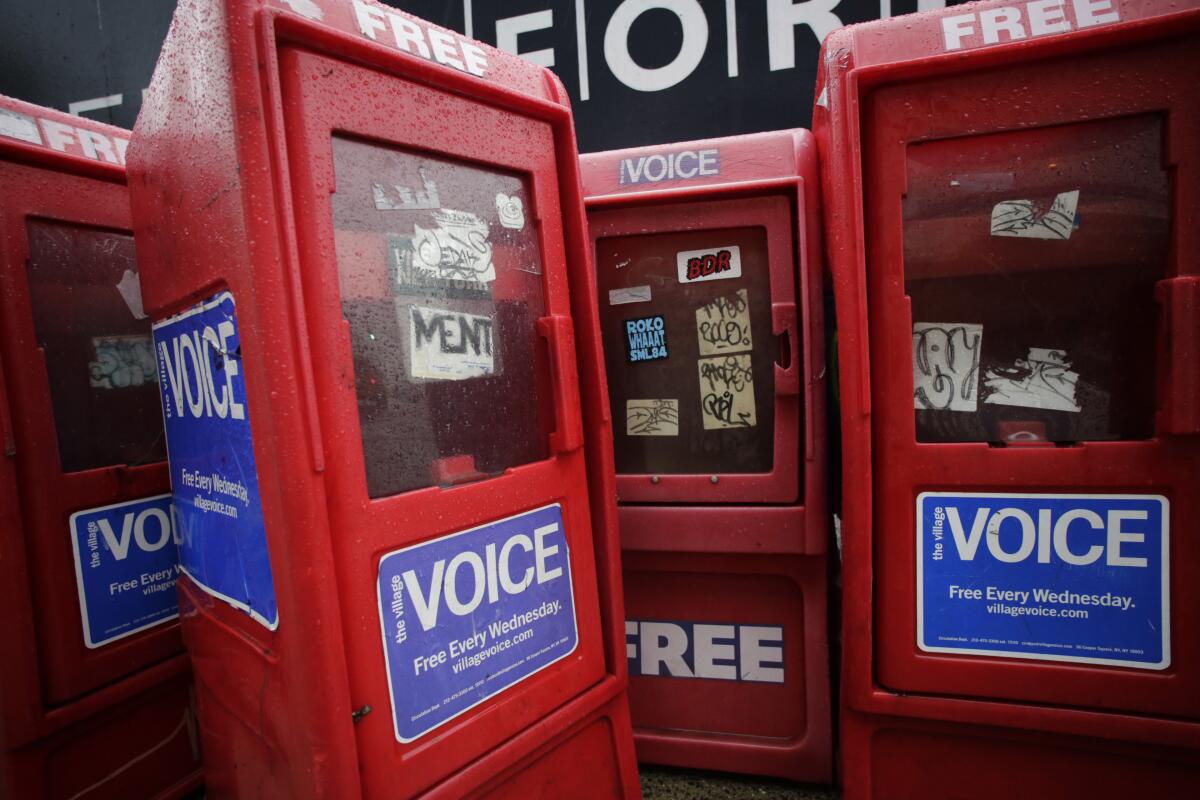Alt-weeklies thought they’d been through the worst economically. Then came coronavirus

- Share via
In the world of alternative weeklies, the foul-mouthed journalism genre that saw its heyday during the 1990s but which has struggled to adapt to the Internet age, the Stranger is the gold standard.
The Seattle paper long ago diversified its revenue stream with innovations — a ticketing service, film festivals, reader events, even the creation of a content management system — that helped the publication pivot away from relying solely on ads.
Profitability, a Pulitzer Prize for feature writing and a national audience soon followed. Competitors emulated the model to varying degrees of success.

Then came the coronavirus outbreak.
On March 13, editor Christopher Frizzelle announced in a blog post that he had to suspend the print edition and lay off 18 staffers, including six in the editorial department “due to the hellscape of unforeseen economic events brought on” by the pandemic.
A statewide shutdown of bars and restaurants eliminated most of the Stranger’s distribution points. A Washington state mandate to limit gatherings to no more than 50 people decimated its ticketing service.
Roughly 90% of its ads disappeared “in a day,” said publisher Laurie Saito, who has been with the Stranger for 20 years. “It was a sound business model we had, until nobody was able to do anything.”
The same story is playing out at alt-weeklies across the country.
In the past seven days, at least 13 of them from Monterey to San Antonio, Tampa Bay to Detroit, let go of reporters. Isthmus, serving Madison, Wis., since 1976, shut down indefinitely, as did the Sacramento News & Review and its sister papers in Reno and Chico.
Dozens more have published pleas to readers for donations. The Austin Chronicle, which had to cancel its South by Southwest festival earlier this month, revealed a staffer tested positive for COVID-19.
The economic forecast for local newspapers in general was miserable long before the pandemic, which has only deepened their woes.
“They’re very vulnerable” to economic calamities because of their weakened state, said Rick Edmonds, a media business analyst at the nonprofit Poynter Institute.
“There’s a number of them that are going to fail, and there’s going to be fairly more quickly,” he said.
Because their business model depends on people leaving their homes, alt-weeklies are taking it hardest.
Some of the papers haven’t lost their sense of humor: Doyle Murphy, editor in chief of the Riverfront Times in St. Louis, ended his story announcing the loss of seven employees with the note, “Just one more thing: F-- COVID-19 and wash your hands.”
But most in the industry aren’t as cheeky in the face of doom.
“This is cataclysmic for the alt-weekly world,” said Jimmy Boegle, editor-publisher of the Coachella Valley Independent, a monthly since its start in 2013. “And it’s been just one week.”
Scott Tobias is the CEO of Voice Media Group, which runs papers in five cities, sent a letter to his employees announcing immediate salary reductions of 25% and likely layoffs. “The calendar says it will soon be spring,” he wrote. “But our country is bracing for a long, cold winter.”
The development comes at a crossroads for the industry. After a decade that saw dozens of papers shutter -- including iconic names such as the Village Voice, the San Francisco Bay Guardian and the Boston Phoenix -- those that remained felt they were finally seeing better days ahead.
Brian Calle, who purchased LA Weekly in 2017 and controversially let go of nearly the entire editorial staff, said this week that he had recently hired four people and was about to bring on one more.
“It was probably the best situation LA Weekly had been in a long time, just a couple of weeks ago,” he said. “And then, coronavirus.”
Calle said he has no plans to furlough any of the paper’s 30 employees, eight of whom make up the newsroom. “But we’re in uncharted terrain that no one really knows how to navigate.”
The problem isn’t just limited to American publications, either: In England, the London-based newspaper City AM shut down its print edition “until our readers start returning to the capital.”
But even as remaining alt-weeklies mourn, they trudge on.
The Stranger’s remaining staff continues to aggressively report on the coronavirus crisis in Washington, the initial U.S. epicenter.
Previous disturbances like 9/11 and the Great Recession forced publications to “find a different way, and they continued along with that when things improved,” said Saito, the publisher.
Boegle, who only has one full-time employee at the Coachella Valley Independent, is about to send the April edition to print, and just started a daily newsletter that has had an “overwhelming” response from readers.
“We’re stuck at home anyway,” he said. “Why not keep journalism going as best as we can?”
More to Read
Sign up for Essential California
The most important California stories and recommendations in your inbox every morning.
You may occasionally receive promotional content from the Los Angeles Times.











